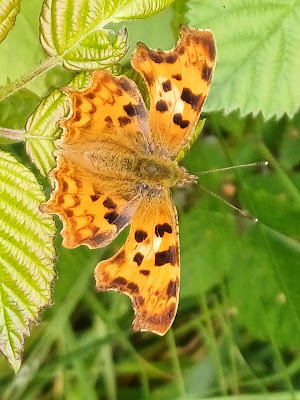 |
| Small tortoiseshell |
September marks the end of the butterfly transect recording season by UKBMS (UK Butterfly Monitoring Scheme). Generally, a transect is a site of butterfly habitat, and a method to monitor the changes of butterfly abundance and variety over the years. The data from each transect is incorporated into the national database, evidencing how well each butterfly species is faring in terms of number and distribution. This in turn informs conservation strategies.
 |
| Comma |
This year at NFBP (New Ferry Butterfly Park) transect, we recorded 20 butterfly species and 553 individuals. Delightfully, Brimstone (53), Small White (123), Speckled Wood (100), Large White (45) and Orange Tip (23) were doing well and scored higher than last year. We were very pleased to see some species absent in the Park in the past turned up this year: Small Tortoiseshell (5), Painted Lady (1) and the rarity Ringlet (2). Dingy Skipper (2) was still hanging on in small numbers. Sadly, Holly Blue (11), Common Blue (18), Comma (19) and Gatekeeper (19) scored lower than last year, and no Small Coppers at all throughout the season.
 |
| Dingy skipper |
As transect recorders we carry out weekly walks for 26 weeks between April and September. Following a pre-determined route and walking at a steady and slow pace, we scan the area and record the butterflies we see.
 |
| Brimstone |
Butterflies use sunlight to warm up their flying muscles. Therefore, transect walks need to be done during daytime between 10.45am and 3.45pm and under suitable weather conditions to maximising the sighting of butterflies. Recording is avoided if it is raining, too cloudy, too cold, and too windy. When the weather become more unpredictable (like this year), a recorder needs to check the weather forecast and grab the first suitable opportunity to do the job.
 |
| Common blue |
Needless to say, identification skills are crucial to accurately record each butterfly species. This can be challenging and frustrating, particularly when butterflies are in flight. Having a butterfly guidebook can help to recognise different species, and understand their habitats, flight times, and behaviours. Field trips with an expert is an excellent way to learn. Fortunately, during our “formative” years in butterflies, we had the support from Kathryn Fegan and Dave Costello (Butterfly Conservation Society) at Hoylake Willows transect in 2023, and Pat Thurston at NFBP in 2024. We are ever grateful for their help. Next year, we will carry on the transect walks together - two pairs of eyes are better than one!
 |
| Small white |
Learning butterflies (or any other wildlife species) gets people closer to nature and can be very rewarding. At NFBP, butterfly ID sheets are available for visitors, and wardens are there to help whenever they can. We look forward to meeting more butterfly enthusiasts in the new season!
 |
| Ringlet |
Blog article: Yan and Charles
Photos: Roy Lowry

















